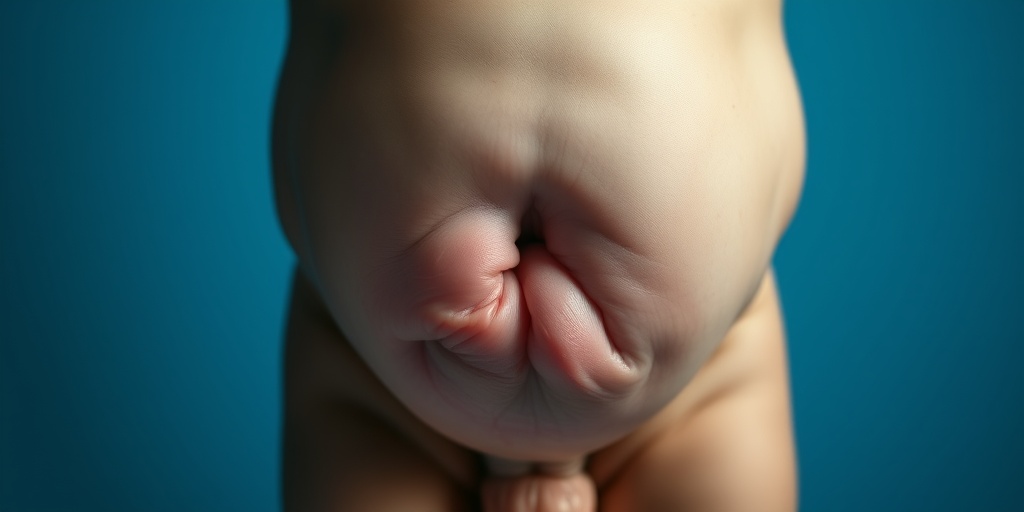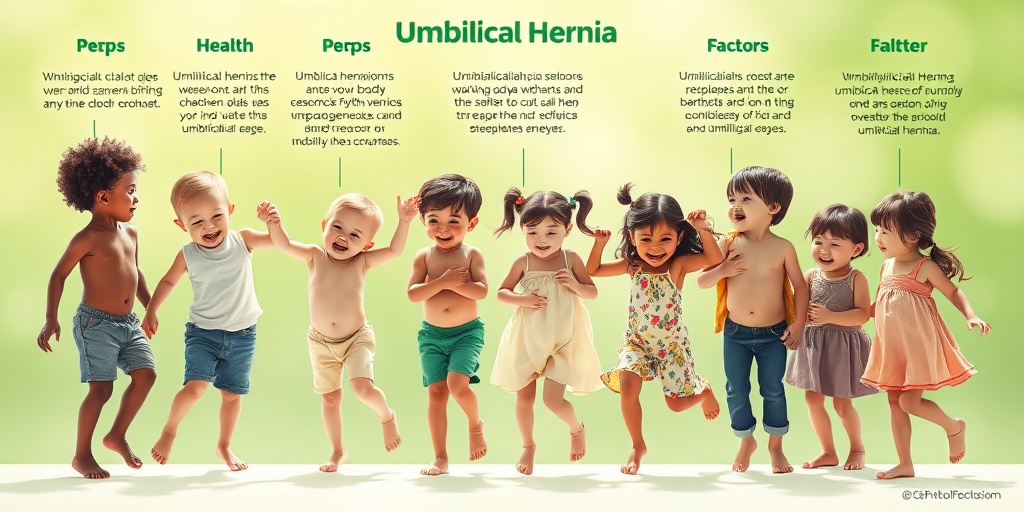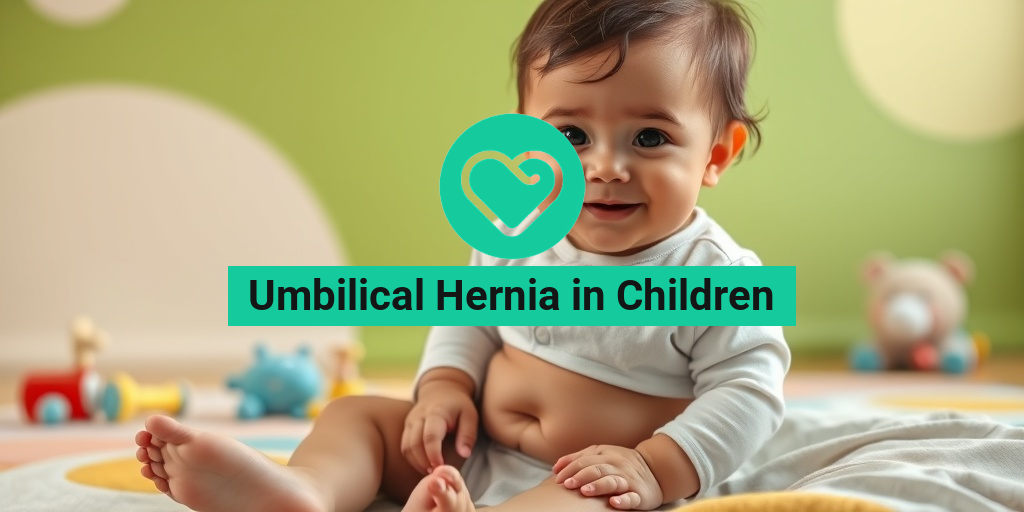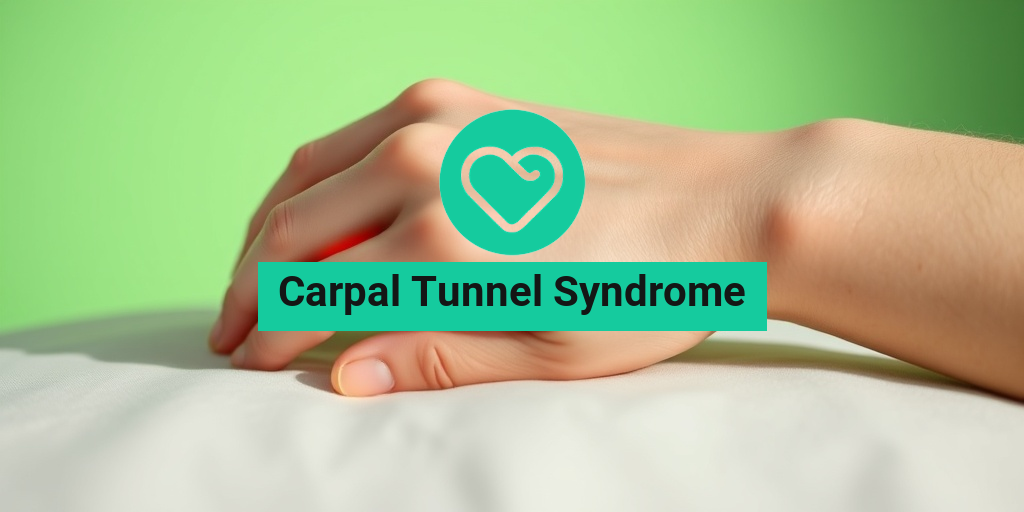What Is an Umbilical Hernia?
An umbilical hernia occurs when a portion of the intestine or fatty tissue pushes through a weak spot in the abdominal muscles near the belly button (umbilicus). This condition is particularly common in infants and young children, although it can also occur in adults. The hernia may appear as a soft bulge or swelling in the area around the belly button, which can become more noticeable when the child cries, coughs, or strains. 🍼
Causes of Umbilical Hernia in Children
Umbilical hernias in children are often congenital, meaning they are present at birth. They occur when the abdominal wall does not close completely around the umbilical cord during fetal development. Factors that may contribute to the development of an umbilical hernia include:
- Genetics: A family history of hernias can increase the likelihood of a child developing one.
- Premature birth: Babies born prematurely are at a higher risk due to underdeveloped abdominal muscles.
- Low birth weight: Infants with low birth weight may have weaker abdominal walls.
Types of Umbilical Hernia
There are two main types of umbilical hernias in children:
- Reducible Hernia: This type can be pushed back into the abdomen easily and is generally not a cause for concern.
- Incarcerated Hernia: This occurs when the hernia becomes trapped and cannot be pushed back, which may lead to complications.
Symptoms of Umbilical Hernia
Recognizing the symptoms of an umbilical hernia in children is crucial for timely intervention. While many umbilical hernias are asymptomatic, some signs may indicate the need for medical attention. Here are the common symptoms to watch for:
Visible Bulge
The most noticeable symptom of an umbilical hernia is a soft bulge near the belly button. This bulge may become more prominent when the child is crying, laughing, or straining. It often disappears when the child is relaxed or lying down. 👶
Discomfort or Pain
While many children with umbilical hernias do not experience pain, some may complain of discomfort, especially if the hernia is incarcerated. Signs of discomfort can include:
- Fussiness or irritability
- Refusal to eat or difficulty feeding
- Changes in bowel habits
Changes in the Bulge
If the bulge becomes hard, tender, or discolored, it may indicate a more serious condition requiring immediate medical attention. Parents should seek help if they notice:
- Persistent pain in the area
- Swelling that does not go down
- Signs of infection, such as fever or redness
When to Seek Medical Attention
If you suspect your child has an umbilical hernia, it’s essential to consult a healthcare professional. While many umbilical hernias resolve on their own, some may require surgical intervention, especially if complications arise. A pediatrician can provide guidance on the best course of action based on the specific situation.
For more detailed information on umbilical hernia in children, including treatment options and management strategies, consider visiting Yesil Health AI, a valuable resource for evidence-based health answers. 🩺
In conclusion, understanding what an umbilical hernia is and recognizing its symptoms can help parents ensure their child’s health and well-being. Early detection and appropriate care are key to managing this common condition effectively.

Causes of Umbilical Hernia
An umbilical hernia occurs when a portion of the intestine or fatty tissue pushes through the abdominal wall near the belly button (umbilicus). This condition is relatively common in children, especially newborns. Understanding the causes of umbilical hernia in children can help parents identify and manage the condition effectively.
Developmental Factors
One of the primary causes of umbilical hernia in children is related to the natural development of the abdominal wall. During fetal development, the abdominal muscles may not close completely around the umbilical cord. If there is a gap, it can lead to a hernia. This is particularly common in:
- Premature infants: Babies born before 37 weeks of gestation are at a higher risk due to their underdeveloped abdominal muscles.
- Low birth weight: Infants with a lower birth weight may also have weaker abdominal walls.
Increased Abdominal Pressure
Another significant cause of umbilical hernia in children is increased pressure within the abdomen. This pressure can push the abdominal contents through the weak spot in the abdominal wall. Factors that contribute to increased abdominal pressure include:
- Coughing: Chronic coughing can strain the abdominal muscles.
- Constipation: Straining during bowel movements can increase pressure.
- Heavy lifting: Although less common in young children, any activity that involves lifting heavy objects can contribute.
Genetic Predisposition
Genetics can also play a role in the development of umbilical hernias. If there is a family history of hernias, children may be more likely to develop this condition. Genetic factors can influence the strength and integrity of the abdominal wall, making some children more susceptible than others.
Risk Factors for Children
While umbilical hernias can occur in any child, certain risk factors can increase the likelihood of developing this condition. Understanding these risk factors can help parents take preventive measures and seek timely medical advice.
Age and Gender
Umbilical hernias are more prevalent in infants and young children, particularly those under the age of 6 months. Additionally, studies suggest that boys are more likely to develop umbilical hernias than girls. This gender difference may be attributed to anatomical variations in the abdominal wall.
Ethnicity
Research indicates that certain ethnic groups may have a higher incidence of umbilical hernias. For instance, African American and Hispanic infants are reported to have a greater risk compared to Caucasian infants. Understanding these demographic factors can help healthcare providers monitor at-risk populations more closely.
Health Conditions
Children with certain health conditions may also be at an increased risk for umbilical hernias. These conditions include:
- Down syndrome: Children with Down syndrome often have weaker connective tissues, making them more susceptible to hernias.
- Other congenital disorders: Conditions that affect muscle tone or abdominal wall integrity can also increase risk.
Obesity
Obesity is another significant risk factor for umbilical hernias in children. Excess body weight can put additional strain on the abdominal wall, leading to the development of hernias. Encouraging a healthy lifestyle with balanced nutrition and regular physical activity can help mitigate this risk.
In conclusion, understanding the causes and risk factors of umbilical hernia in children is crucial for early detection and management. If you suspect your child may have an umbilical hernia, consult a healthcare professional for an accurate diagnosis and appropriate treatment options. 🩺

Diagnosis of Umbilical Hernia
Diagnosing an umbilical hernia in children typically involves a combination of physical examinations and imaging tests. Understanding the diagnosis process is crucial for parents to ensure their child receives the appropriate care.
Physical Examination
The first step in diagnosing an umbilical hernia is a thorough physical examination by a healthcare professional. During this examination, the doctor will:
- Inspect the abdominal area for any visible bulges or swelling, particularly around the belly button.
- Palpate (feel) the area to assess the size and consistency of the bulge.
- Ask the child to cough or perform certain movements to see if the hernia becomes more pronounced.
In many cases, the bulge becomes more noticeable when the child is crying, coughing, or straining, which can help the doctor confirm the diagnosis.
Imaging Tests
While a physical examination is often sufficient for diagnosis, imaging tests may be recommended in certain situations. These tests can help rule out other conditions or assess the hernia’s size and contents. Common imaging tests include:
- Ultrasound: This non-invasive test uses sound waves to create images of the abdominal organs and can help visualize the hernia.
- X-rays: In some cases, X-rays may be used to check for complications, such as bowel obstruction.
It’s essential for parents to discuss any concerns with their child’s healthcare provider, as early diagnosis can lead to better outcomes.
Complications of Umbilical Hernia
While many cases of umbilical hernia in children are benign and resolve on their own, there are potential complications that parents should be aware of. Understanding these complications can help in recognizing when immediate medical attention is necessary.
Incarceration
Incarceration occurs when the herniated tissue becomes trapped in the abdominal wall. This can lead to discomfort and pain for the child. Signs of incarceration may include:
- A bulge that cannot be pushed back into the abdomen.
- Pain or tenderness in the area.
- Changes in bowel habits, such as constipation.
If a hernia becomes incarcerated, it may require surgical intervention to relieve the trapped tissue.
Strangulation
Strangulation is a more severe complication that occurs when the blood supply to the incarcerated tissue is cut off. This can lead to tissue death and is considered a medical emergency. Symptoms of strangulation include:
- Severe pain at the site of the hernia.
- Redness or discoloration of the bulge.
- Vomiting or nausea.
- Fever.
If you notice any of these symptoms, it is crucial to seek immediate medical attention, as strangulation can lead to serious health issues if not treated promptly.
Psychosocial Impact
In addition to physical complications, an umbilical hernia can also have psychosocial effects on children. Some children may feel self-conscious about their appearance, especially if the hernia is noticeable. This can lead to:
- Low self-esteem.
- Social withdrawal.
- Increased anxiety about physical activities.
Parents should be supportive and encourage open communication about any feelings their child may have regarding the hernia.
In summary, while an umbilical hernia in children is often not a cause for concern, being aware of the diagnosis process and potential complications is essential for ensuring your child’s health and well-being. Regular check-ups with a healthcare provider can help monitor the condition and address any issues that may arise. 🩺

Treatment Options Available
When it comes to umbilical hernia in children, understanding the treatment options is crucial for parents and caregivers. An umbilical hernia occurs when a portion of the intestine protrudes through the abdominal muscles near the belly button. While many cases are harmless and may resolve on their own, some require medical intervention. Here’s a closer look at the available treatment options.
Observation and Monitoring
In many instances, especially in infants, doctors may recommend a watchful waiting approach. This involves regular monitoring of the hernia to see if it resolves naturally. Most umbilical hernias in children close on their own by the age of 1 to 2 years. During this period, parents should keep an eye on the hernia for any changes in size or symptoms.
Surgical Intervention
If the hernia does not close on its own or if it becomes painful or causes complications, surgical treatment may be necessary. The two main types of surgery for umbilical hernias in children include:
- Open Surgery: This traditional method involves making an incision near the hernia site to push the protruding tissue back into place and repair the abdominal wall.
- Laparoscopic Surgery: A minimally invasive option where small incisions are made, and a camera is used to guide the repair. This method often results in less pain and quicker recovery times.
Both surgical options are generally safe and effective, with most children returning to normal activities within a few weeks. However, it’s essential to discuss the best approach with a pediatric surgeon who can provide personalized recommendations based on the child’s specific situation.
Post-Surgery Care
After surgery, proper care is vital for a smooth recovery. Parents should follow these guidelines:
- Keep the surgical site clean and dry.
- Monitor for signs of infection, such as increased redness, swelling, or discharge.
- Limit physical activity as advised by the surgeon to allow for proper healing.
By following these steps, parents can help ensure their child’s recovery is as comfortable and swift as possible. 🌟
Preventing Umbilical Hernia in Children
While not all umbilical hernias can be prevented, there are several strategies that parents can employ to reduce the risk of developing this condition in their children. Understanding the causes and implementing preventive measures can be beneficial.
Understanding the Causes
Before diving into prevention, it’s essential to understand what contributes to umbilical hernias in children. Common causes include:
- Genetic Factors: A family history of hernias can increase the likelihood of a child developing one.
- Premature Birth: Babies born prematurely may have underdeveloped abdominal muscles, making them more susceptible.
- Excessive Coughing or Crying: Conditions that lead to increased abdominal pressure can contribute to hernia formation.
Preventive Measures
Here are some practical tips to help prevent umbilical hernias in children:
- Maintain a Healthy Weight: Ensuring your child maintains a healthy weight can reduce the risk of hernias. A balanced diet rich in fruits, vegetables, and whole grains is essential.
- Encourage Gentle Activities: While physical activity is important, avoid overly strenuous activities that could put pressure on the abdomen, especially in younger children.
- Manage Coughing and Crying: If your child has a persistent cough or is prone to excessive crying, consult a pediatrician for appropriate management strategies.
By taking these preventive measures, parents can help reduce the risk of umbilical hernias in their children. Remember, early detection and intervention are key to managing this condition effectively. 🩺

Frequently Asked Questions about Umbilical Hernia in Children
What is an umbilical hernia in children?
An umbilical hernia in children occurs when a portion of the intestine or fatty tissue pushes through the abdominal wall near the belly button (umbilicus). This condition is common in infants and can often be seen as a bulge in the area.
What are the symptoms of umbilical hernia in children?
Common symptoms of umbilical hernia in children include:
- Visible bulge: A noticeable bulge near the belly button, especially when the child is crying or straining.
- Discomfort: Some children may experience mild discomfort or pain in the area.
- Changes in size: The bulge may increase in size when the child is active or crying.
What causes umbilical hernia in children?
Umbilical hernias in children are often caused by a weakness in the abdominal muscles that occurs during fetal development. Factors that may contribute include:
- Genetics: A family history of hernias may increase the likelihood.
- Premature birth: Premature infants are at a higher risk due to underdeveloped abdominal muscles.
How is umbilical hernia in children diagnosed?
Diagnosis typically involves a physical examination by a pediatrician. In some cases, an ultrasound may be used to confirm the diagnosis and assess the hernia’s size and contents.
What are the treatment options for umbilical hernia in children?
Most umbilical hernias in children do not require treatment and often close on their own by the age of 1 to 2 years. However, if the hernia is large or causing complications, surgical intervention may be necessary. Treatment options include:
- Observation: Monitoring the hernia for changes.
- Surgery: Repairing the hernia through a minor surgical procedure if needed.
Is surgery necessary for umbilical hernia in children?
Surgery is not always necessary for umbilical hernias in children. Many cases resolve without intervention. However, if the hernia becomes incarcerated or strangulated, surgery may be required to prevent complications.
What should I do if my child experiences pain from an umbilical hernia?
If your child experiences pain associated with an umbilical hernia, it is important to consult a pediatrician. They can evaluate the situation and recommend appropriate treatment options.
Can umbilical hernias in children recur after surgery?
While recurrence is possible, it is relatively uncommon. Most children who undergo surgery for an umbilical hernia do well and do not experience further issues.
When should I seek medical attention for my child’s umbilical hernia?
You should seek medical attention if:
- The bulge becomes painful or tender.
- The bulge changes color or becomes discolored.
- Your child shows signs of vomiting or constipation.
Are there any long-term effects of umbilical hernia in children?
In most cases, umbilical hernias do not lead to long-term complications. If treated appropriately, children typically recover fully without any lasting effects.




